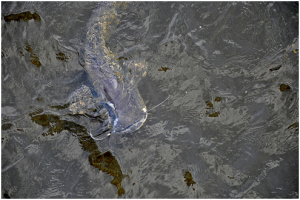
By Stevie Georgiou, Staff Writer for Save The Water™ | September 16, 2015
The Chernobyl disaster of 1986 is one of the 20th century’s most catastrophic incidents of radioactive water contamination. A sudden power surge in reactors caused a devastating explosion. Then, deadly levels of radiation left Prypiat River lifeless.1 Water-dwellers experienced a high level of toxic chemical intake. This turned the polluted waters of Chernobyl into a no-breeding zone. However, there have been recent reports of large, mutant catfish flourishing within the Prypiat River.2
Animals in Waters of Chernobyl, Prypiat River Seem Healthy, Although Huge
According to recent scientific research, the waters of Chernobyl have been plagued with radionuclides ever since the explosion. In turn, this has strangely increased the size of catfish within the Ukraine. Radionuclidse are atoms that hold an excess amount of radioactive energy. This energy creates unpredictable actions like mutations or deformed growth. Such radiation can cause mutations in all parts of the human anatomy. Catfish exposed to these levels of radionuclides have grown from 4 feet to a whopping 9-12 feet over the span of 29 years.3
The waters of Prypiat River have some of the highest levels of water radiation in the world. Despite their size, scientists have examined these catfish and found them perfectly healthy. Moreover, species such as bears, lynx, and wild boars have all been seen drinking from the contaminated water of the Prypiat River, but these animals are also flourishing. That is to say, they show no signs of mutation.4 Could this mean that certain life forms adapt to the conditions of water radiation over a limited period of time?
Humans Cannot Handle Radioactive Water, Gigantic Catfish Thrive
Despite this discovery, radiation within contaminated water is still something that the human immune system cannot handle. According to the United States Environmental Protection Agency, drinking water that contains high levels of radioactive contaminants (such as uranium) can often cause cancer and kidney problems.5 For humans, radioactive water is lethal. For example, three Russian divers tried to clean up the polluted waters of Chernobyl two weeks after the explosion. But their bodies could not cope with the waters’ radioactivity. Sadly, all three died just 14 days later.6 Cancer continues to claim many human lives today. But rather than dying or becoming terminally deformed, Chernobyl’s catfish have instead adapted into what appears to be a new species.
We Don’t Know Much About the Effects of Waterborne Radionuclides on Organisms
There is still much to be discovered regarding the effects of waterborne radionuclides on organisms. As a result, Save the Water™ strives to improve water science and educate the public about sanitary and sustainable practices. For more information on our global projects, visit our website. Any contributions you can make will go a long way towards supporting our development of water technology and our efforts to ensure people around the world enjoy access to clean and safe water.
References:
- Peter Lekarve. September 1, 2015. “The Chernobyl Disaster: Greatest Nuclear Power Tragedy.” Sputnik News. https://sputniknews.com/in_depth/201509011026442511/
- Daily Star. July 9, 2014. “VIDEO: Are These Giant Fish in Chernobyl Radioactive Mutants?” Daily Star. https://www.dailystar.co.uk/news/latest-news/388076/Russian-anglers-hunt-giant-mutant-fish
- Channel 4 News. July 2015. “Chernobyl: Inside the Exclusion Zone.” Youtube. https://youtu.be/khv87k68kIs
- Robin Esrock. March 11, 2014. “16 Spooky as Hell Photos From Inside Chernobyl.” Mental Floss. http://mentalfloss.com/article/55494/16-spooky-hell-photos-inside-chernobyl
- United States Environmental Protection Agency. March 6, 2012. “Radionuclides Rule.” United States Environmental Protection Agency. https://www.epa.gov/dwreginfo/radionuclides-rule
- The Scotsman. March 16, 2011. “Stephen McGinty: Lead Coffins and a Nation’s Thanks for the Chernobyl Suicide Squad”. The Scotsman. http://bit.ly/1JM2qKN

